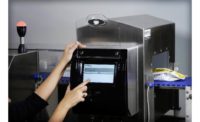Leap in Technology
by Josh Lipsky
Senior Editor
Senior Editor
Loader manufacturers responded to customer feedback to offer machines featuring improved sanitary design and operating control.
To increase productivity, hot-dog producers are turning to automated processes, combining high-speed thermoform-fill-seal technology with loaders to produce more than 200 single-layer packs of skinless hot dogs per minute. Automating this part of the production process improves accuracy, speed, repeatability, and process control.
As packaging systems improve enabling hot dogs to be kept in wrinkle-free and perfectly sealed packages, hot-dog loaders are also improving allowing them to be cleaned easier and improving their touch-screen programmability.
Two loader companies taking major leaps forward are Waynesboro, VA-based F.R. Drake Co., and Cincinnati, OH-based Planet Products Corp.
Two loader companies taking major leaps forward are Waynesboro, VA-based F.R. Drake Co., and Cincinnati, OH-based Planet Products Corp.
Sanitary design demands
At last year’s Worldwide Food Expo both companies introduced hot-dog loaders that featured improved sanitary design. Planet Products says its SP3 Planet Loader has the least number of total components and the least amount of surface area of any available hot-dog collating system.
“The additional design feature where this entire unit disassembles for cleaning or service in minutes without tools demonstrates that Planet has listened to our customer feedback carefully,” says John Abraham, vice president of sales for Planet Products.
Drake also showcased a loader with an improved sanitary design at the Worldwide Food Expo.
Drake also showcased a loader with an improved sanitary design at the Worldwide Food Expo.
“We had already completed a massive design effort two years earlier, upgrading our standard machines to make them easier to clean,” explains Russ Martin, president of F.R. Drake. “Drake loaders are in compliance with the American Meat Institute’s ten Principles of Sanitary Design, but we recognize that sanitary design must continue to be improved each year. Features such as solid, one-piece rollers, welded sprockets, welded bearing stand-offs, stainless steel frame and casters, and open accessibility are necessities. Drake has also added etched warning labels to eliminate stick-on labels that can trap pathogens, an option for all stainless steel electrical conduit to replace plastic conduit, and an option for remote mounting of the main electrical cabinet.”
Improved operator controls
Touch-screen technology continues to evolve, and hot-dog loader equipment is embracing these advancements.
Drake loaders come standard with a color touch-screen display. The liquid-tight control package now features:
-Pre-programming and storage of all customer recipes
-Each loader is equipped with a modem for remote access. Through the modems, Drake engineers can dial-in, access the controls, perform troubleshooting, and offer program enhancements.
-Servo motors provide versatility for changing recipes. Timing changes are made with the touch of a button, and those timing changes can be stored in the operator controls’ memory.
-The electrical control cabinet can be mounted away from the loader, with a conduit run up to 150 feet long. An Ethernet network allows the operator to remotely track production efficiency and total throughput.
Drake loaders come standard with a color touch-screen display. The liquid-tight control package now features:
-Pre-programming and storage of all customer recipes
-Each loader is equipped with a modem for remote access. Through the modems, Drake engineers can dial-in, access the controls, perform troubleshooting, and offer program enhancements.
-Servo motors provide versatility for changing recipes. Timing changes are made with the touch of a button, and those timing changes can be stored in the operator controls’ memory.
-The electrical control cabinet can be mounted away from the loader, with a conduit run up to 150 feet long. An Ethernet network allows the operator to remotely track production efficiency and total throughput.
Suppliers contributing to this feature:
- F.R. Drake Company, phone (540) 949-6215, e-mail sales@drakeloader.com, or visit www.drakeloader.com
- Planet Products, phone (513) 984-5544, e-mail sales@planet-products.com, or visit www.planet-products.com
- F.R. Drake Company, phone (540) 949-6215, e-mail sales@drakeloader.com, or visit www.drakeloader.com
- Planet Products, phone (513) 984-5544, e-mail sales@planet-products.com, or visit www.planet-products.com
| Where they’re eating them | |
| It’s a good thing loaders enable higher production outputs. Here’s a look at 2003’s top 10 hotdog eating American cities. | |
| (1) Los Angeles | 44,723,360 |
| (2) New York | 35,214,010 |
| (3) Dallas/Ft. Worth | 21,252,530 |
| (4) Chicago | 19,593,140 |
| (5) Baltimore/Washington D.C. | 19,566,890 |
| (6) Philadelphia | 17,491,540 |
| (7) South Carolina | 15,521,860 |
| (8) Atlanta | 14,189,730 |
| (9) Miami/Ft. Lauderdale | 3,069,240 |
| (10) Boston | 10,925,010 |
| Based on retail sales per pound of refrigerated hot dogs during the 52-week period ended Dec. 28, 2003 | |
| Source: American Meat Institute | |
| Preventative Maintenance Schedule | |
| By adhering to a preventative maintenance schedule, operators can ensure accuracy and longevity from their loaders. | |
| PM Item | Frequency |
| Lubricate all bearings | Daily |
| Make visual inspection of loader | Daily |
| Check for noise and vibrations | Daily |
| Check tension and wear on all drive chains, sprockets, and idler pulleys | Weekly |
| Inspect conveyor belts | Weekly |
| Inspect gearboxes | Weekly |
| Check collator chain tension | Weekly |
| Check intermediate chain tension | Weekly |
| Check pusher chain tension | Weekly |
| Check transfer belt lift control air pressure (40 psi) | Weekly |
| Check product path for damaged or worn parts | Weekly |
| Inspect flight chain, rollers, shoulder screws, and support tracks for wear | Weekly |
| Lubricate Hilliard clutch | Weekly |
| Replace hinge gate springs | 500 hours |
| Change oil in gear reducers | 6 months |
| Replace main air supply filter | 12 months |
| Source: F.R. Drake Company | |





